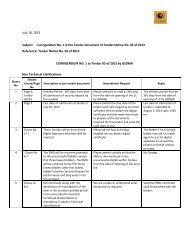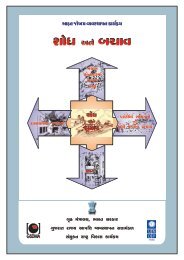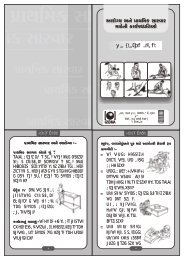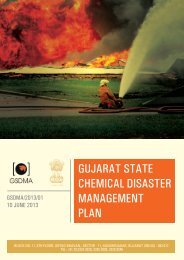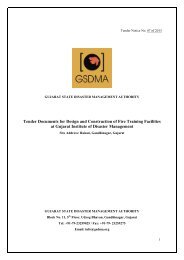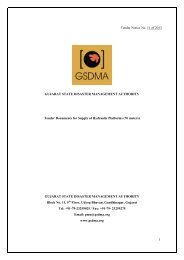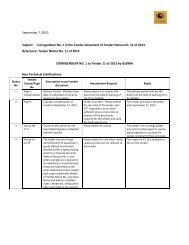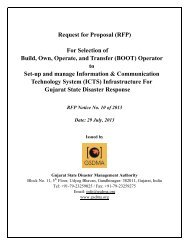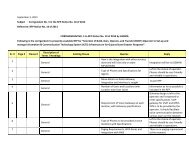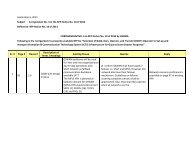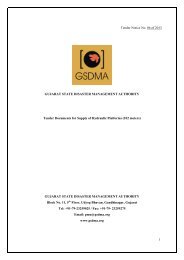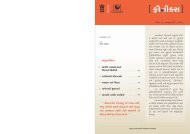Emergency Response Guidebook - Gujarat State Disaster ...
Emergency Response Guidebook - Gujarat State Disaster ...
Emergency Response Guidebook - Gujarat State Disaster ...
You also want an ePaper? Increase the reach of your titles
YUMPU automatically turns print PDFs into web optimized ePapers that Google loves.
GUIDE159Substances (Irritating)ERG2012ERG2012Substances (Irritating)GUIDE159POTENTIAL HAZARDSHEALTH• Inhalation of Vapours or dust is extremely irritating.• May cause burning of eyes and flow of tears.• May cause coughing, difficult breathing and nausea.• Brief exposure effects last only a few minutes.• Exposure in an enclosed area may be very harmful.• Fire will produce irritating, corrosive and/or toxic gases.• Runoff from fire control or dilution water may cause pollution.FIRE OR EXPLOSION• Some of these materials may burn, but none ignite readily.• Containers may explode when heated.PUBLIC SAFETY• CALL EMERGENCY RESPONSE Telephone Number on Shipping Paper first. If Shipping Paper notavailable or no answer, refer to appropriate telephone number listed on the inside back cover.• As an immediate precautionary measure, isolate spill or leak area in all directions for at least 50meters (150 feet) for liquids and at least 25 meters (75 feet) for solids.• Keep unauthorized personnel away.• Stay upwind.• Keep out of low areas.• Ventilate closed spaces before entering.PROTECTIVE CLOTHING• Wear positive pressure self-contained breathing apparatus (SCBA).• Wear chemical protective clothing that is specifically recommended by the manufacturer. It mayprovide little or no thermal protection.• Structural firefighters' protective clothing provides limited protection in fire situations ONLY; it is noteffective in spill situations where direct contact with the substance is possible.EVACUATIONSpill• See Table 1 - Initial Isolation and Protective Action Distances for highlighted materials. Fornonhighlighted materials, increase, in the downwind direction, as necessary, the isolation distanceshown under “PUBLIC SAFETY”.Fire• If tank, rail car or tank truck is involved in a fire, ISOLATE for 800 meters (1/2 mile) in all directions;also, consider initial evacuation for 800 meters (1/2 mile) in all directions.EMERGENCY RESPONSEFIRESmall Fire• Dry chemical, CO 2, water spray or regular foam.Large Fire• Water spray, fog or regular foam.• Move containers from fire area if you can do it without risk.• Dike fire-control water for later disposal; do not scatter the material.Fire involving Tanks or Car/Trailer Loads• Fight fire from maximum distance or use unmanned hose holders or monitor nozzles.• Do not get water inside containers.• Cool containers with flooding quantities of water until well after fire is out.• Withdraw immediately in case of rising sound from venting safety devices or discoloration of tank.• ALWAYS stay away from tanks engulfed in fire.• For massive fire, use unmanned hose holders or monitor nozzles; if this is impossible, withdraw fromarea and let fire burn.SPILL OR LEAK• Do not touch or walk through spilled material.• Stop leak if you can do it without risk.• Fully encapsulating, Vapour protective clothing should be worn for spills and leaks with no fire.Small Spill• Take up with sand or other non-combustible absorbent material and place into containers for laterdisposal.Large Spill• Dike far ahead of liquid spill for later disposal.• Prevent entry into waterways, sewers, basements or confined areas.FIRST AID• Move victim to fresh air.• Call 108 or emergency medical service.• Give artificial respiration if victim is not breathing.• Do not use mouth-to-mouth method if victim ingested or inhaled the substance; give artificialrespiration with the aid of a pocket mask equipped with a one-way valve or other proper respiratorymedical device.• Administer oxygen if breathing is difficult.• Remove and isolate contaminated clothing and shoes.• In case of contact with substance, immediately flush skin or eyes with running water for at least 20minutes.• For minor skin contact, avoid spreading material on unaffected skin.• Keep victim warm and quiet.• Effects should disappear after individual has been exposed to fresh air for approximately 10 minutes.• Ensure that medical personnel are aware of the material(s) involved and take precautions to protectthemselves.Page 258Page 259



